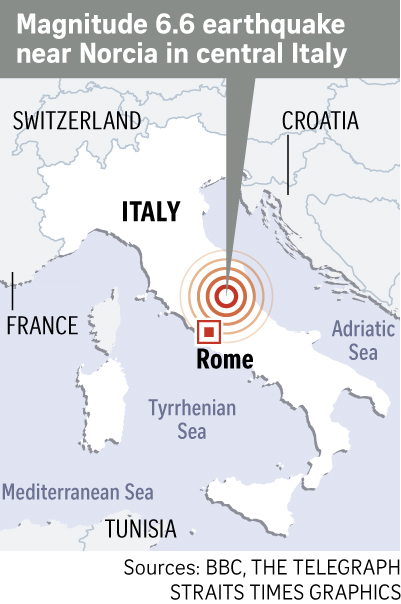Buildings collapse after new strong earthquake in central Italy, several people reported injured
Sign up now: Get ST's newsletters delivered to your inbox
Follow topic:
ROME (REUTERS, AFP) - A strong earthquake measuring 6.6 magnitude struck central Italy on Sunday (Oct 30), causing the collapse of more buildings in small cities and towns already shaken by tremors in the past two months, with several reported injuries.
Fabrizio Curcio, head of the national civil protection agency, said around a dozen people had been injured but that there did not appear to have been any fatalities.
"We are checking, there are several people injured but for the moment we have had no reports of victims," Curcio said.
It was a bigger quake than the one which hit central Italy on Aug 24, killing almost 300 people. There have been thousands of aftershocks in the weeks since then, including two particularly strong tremors last Wednesday.
It measured 6.6 on the so-called moment magnitude scale, according to US geologists, while Italian monitors estimated it at 6.5.
Italy's emergency services said there was serious damage in multiple locations in the central regions of Marche and Umbria on Sunday.
State broadcaster RAI said three people were rescued from rubble in the town of Ussita, but there were no reports of deaths.
"Everything collapsed. I can see columns of smoke, it's a disaster, a disaster," Marco Rinaldi, the mayor of Ussita, one of the pretty mountain villages hit hardest by the last quake, told journalists. "I was sleeping in my car, I saw hell break out," he was quoted as saying.
The quake set dogs barking in the largely-abandoned towns of Norcia, Castelsantagelo, Preci and Visso, where residents had left their homes to sleep in cars or moved to the coast following this week's quakes.
Live television coverage showed the collapse of a church in the centre of Norcia, a town near Perugia in Umbria. Parts of the town had already been sealed off.
The ancient Basilica of St. Benedict in the walled town of Norcia, almost 100 kilometres from Perugia, was devastated by the quake, the monks said. Italy's Sky News 24 showed monks on their knees praying silently in front of the outdoor statue of St Benedict of Norcia, while scared residents stood by.
Images on television showed one side of the church reduced to rubble, and another church in the town centre also collapsed.

Prime Minister Matteo Renzi promised a massive reconstruction effort regardless of cost and took advantage of the disaster to resume his frequent criticism of the European Union's public finance rules.
"We will rebuild everything, the houses, the churches and the businesses," he told reporters. "Everything that needs to be done to rebuild these areas will be done."
He said he would have "no regard for technocratic rules" and would consider all money spent to make Italy's schools and hospitals earthquake-proof to be outside EU limits on budget deficits.
Local authorities said many towns and villages already battered by the 6.2 quake in August had seen further significant damage.
"This morning's quake has hit the few things that were left standing. We will have to start from scratch," Michele Franchi, the deputy mayor of Arquata del Tronto, told Rai television.
Many of these places were evacuated after the August disaster and were largely deserted on Sunday morning when the quake hit at around 7.40am local time (2.40pm Singapore). The earthquake was felt as far north as Bolzano, near the border with Austria and as far south as the Puglia region at the southern tip of the Italian peninsula.
It was also felt strongly in the capital Rome, where transport authorities closed down the metro system for checks.
Italy sits on two fault lines, making it one of the most seismically active countries in Europe.
Before this year, the last major earthquake to hit the country struck the central city of L'Aquila in 2009, killing more than 300 people.
The most deadly since the start of the 20th century came in 1908, when an earthquake followed by a tsunami killed an estimated 80,000 people in the southern regions of Reggio Calabria and Sicily.

